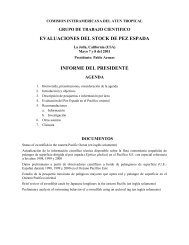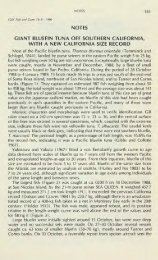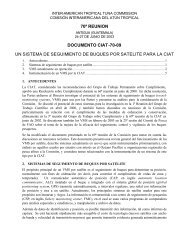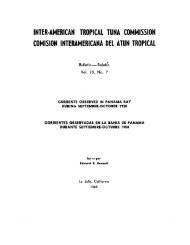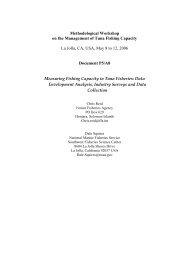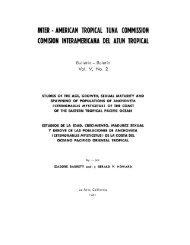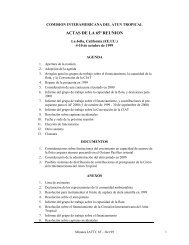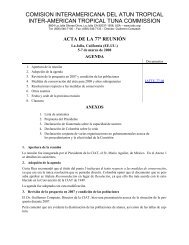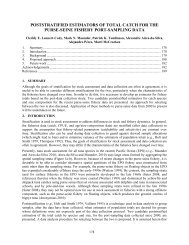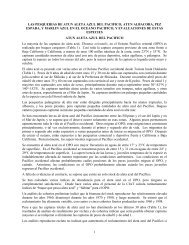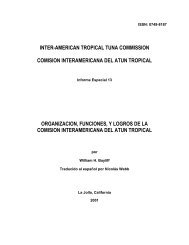Informe Anual de la Comisión Interamericana del Atún Tropical, 19
Informe Anual de la Comisión Interamericana del Atún Tropical, 19
Informe Anual de la Comisión Interamericana del Atún Tropical, 19
You also want an ePaper? Increase the reach of your titles
YUMPU automatically turns print PDFs into web optimized ePapers that Google loves.
ANNUAL REPORT <strong>19</strong>87<br />
STATUS OF THE TUNA STOCKS IN <strong>19</strong>87<br />
AND OUTLOOK FOR <strong>19</strong>88<br />
It is the responsibility of the IATTC staff to monitor the fiuctuations in abundance of the<br />
tropical tunas ofthe eastern Pacific Ocean and to assess the effects of man's activities and natural<br />
factors on their abundance. Each year scientific information gathered by the staff is used to make<br />
recommendations for the management of these species. This is accomplished by presenting<br />
information in background documents and orally at the meetings ofthe Commission. To disseminate<br />
this information to the general public it is summarized in this annual reporto<br />
YELWWFIN<br />
The status of yellowfin in the eastern Pacific Ocean has been assessed by the employment of<br />
age-structured mo<strong>de</strong>ls and production mo<strong>de</strong>ls with data collected by the IATTC staff. These results<br />
will be summarized, followed by a discussion of the condition of the resource in <strong>19</strong>87 and<br />
consi<strong>de</strong>rations for <strong>19</strong>88.<br />
Age-structured mo<strong>de</strong>ls<br />
Age-structured mo<strong>de</strong>ls make use of data on recruitment and on the growth and mortality of<br />
individual fish. Estimates of these parameters are obtained from analyses of data on the lengthfrequency<br />
distributions ofthe fish in the catches, supplemented by tag return data and other data of<br />
various types. The IATTC staffhas collected data on the size composition ofthe catches ofyellowfin in<br />
the eastern Pacific Ocean since <strong>19</strong>54, and in addition has had access to the corresponding data<br />
collected during <strong>19</strong>51-<strong>19</strong>54 by the California Department ofFish and Game.<br />
Biomass analyses<br />
Age-structured biomass analyses performed by the IATTC staff have produced information<br />
concerning the abundance and mortality of fish of individual year c<strong>la</strong>sses which has been highly<br />
useful for stock assessment. As afirst step, the fish in the catch must be assigned to cohorts. (A cohort<br />
consists of all the fish recruited to the fishery at the same time, such as the X68 cohort, which first<br />
entered the fishery in small numbers during the first half of <strong>19</strong>68 and contributed to it significanUy<br />
for the first time during the second half of that year, and the Y68 cohort, which first entered the<br />
fishery in small numbers during the second half of <strong>19</strong>67 and contributed to it significanUy for the<br />
first time during the first halfof<strong>19</strong>68.) The recruitments to the Xand Ycohorts have been estimated,<br />
on the average, to be about the same (Table <strong>19</strong>). Then estimates are ma<strong>de</strong> ofthe numbers ofthe fish of<br />
each cohort at the time ofrecruitment and at various intervals thereafter and ofthe numbers which<br />
are caught and which die during each interval. These numbers are converted to weights from data on<br />
the average weights of fish of different sizes to calcu<strong>la</strong>te the biomass estimates. The information<br />
nee<strong>de</strong>d for these calcu<strong>la</strong>tions inclu<strong>de</strong>s the numbers and average weights of fish of each cohort in the<br />
catch, an estimate of the natural mortality rate (or estimates of a series of rates if the natural<br />
mortality is not constant for the fish of different ages), and an estimate ofthe fishing mortality rate<br />
for at least one catch interval for each cohort. These are called the "initiating" rates of fishing<br />
mortality. All ofthese estimates are obtained from analyses ofcatch statistics and length-frequency<br />
and length-weight data. The results of these analyses are not as accurate as <strong>de</strong>sired because,<br />
although fish ofdifferent cohorts can be easily distinguished from one another when they are young,<br />
this becomes increasingly difficult as they grow ol<strong>de</strong>r, so ol<strong>de</strong>r fish are probably often assigned to the<br />
wrong cohorts. Thus not only are the estimates ofthe catches offish ofeach cohort less accurate than<br />
<strong>de</strong>sired, but the estimates ofthe rnortality rates are somewhat cru<strong>de</strong>. Specifical!y, an estimate ofO.8<br />
41



